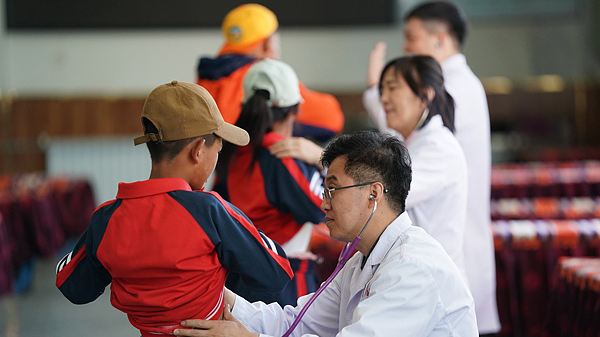Source:CGTN 2025-08-13

Children from a school receive congenital heart disease check-up in Xigaze, southwest China's Xizang Autonomous Region, June 26, 2023. /VCG
At the University of Tibetan Medicine in southwest China's Xizang Autonomous Region, Mikyi Tsomo, a regional inheritor of the intangible cultural heritage of Tibetan medicine, was treating a patient who had traveled more than 600 kilometers to seek her medical help.
"The old Tibetan doctors in our village used to be called 'Great Pandita' when I was a child," Mikyi Tsomo recalled, using a term of high reverence for master healers in Tibetan culture. The girl who followed local doctors around has now become a master healer herself in the eyes of her patients.
Tibetan medicine, known as Sowa Rigpa in Tibetan, with Sowa meaning "nourishment" and Rigpa meaning "knowledge system," is a unique medical tradition developed by the Tibetan people in the high-altitude environment. It is one of China's important systems of traditional medicine.
At the age of five, she first witnessed the magic of traditional Tibetan medicine. A hunchbacked old doctor arrived from the valley, his bag filled with handmade herbal remedies.
"The old doctor simply touched my wrist and accurately identified my illness," she recalled. "I was fascinated and a bit skeptical. Could just a touch really diagnose a disease?"
Driven by curiosity, Mikyi Tsomo began her journey in Tibetan medicine. At 17, after graduating from a school specializing in Tibetan medicine, she was assigned to a local hospital perched at an altitude of 4,500 meters. In these remote pastoral regions, visiting a patient often meant riding for an entire day.
"In the pastoral areas, illnesses can be very complex and unusual," Mikyi Tsomo said, adding that at the time, she juggled the roles of practitioner and student, treating patients during the day and studying medical texts at night.
"Even prescriptions written by our ancestors a thousand years ago remain legible today," she said. "Updated with new medical insights, they will continue to be passed down and carried further into the future."
The right to health is protected in a more balanced way in Xizang
Since Xizang's peaceful liberation in 1951, Tibetan healthcare has undergone a dramatic transformation. At that time, there were only three Tibetan medicine institutions across the entire region. Today, a comprehensive medical system has been established.
The region has formulated and implemented a series of policies on promoting Tibetan medicine and encouraging innovation. It has increased input year by year for the application, education, research and industrial development of this field of medicine. In 2024, there were 51 public Tibetan medicine institutions, up from 28 in 2012. These institutions employed 5,287 professionals, up from 2,232, and housed 3,260 hospital beds, up from 1,364.
All community health service centers, 94.4 percent of township health centers and 50.04 percent of village clinics could provide Tibetan medicine services, up from 50 percent, 71 percent and 15 percent, respectively, in 2012.
The country's first national medical center of ethnic medicine has been approved; a national center for ethnic medicine clinical research, five national-level key clinical specialties and 17 key medical specialties accredited by the National Administration of Traditional Chinese Medicine have been established; and three Tibetan medicine experts were given the title of Master of Chinese Medicine. Efforts are also ongoing to incorporate Tibetan medicines into the National List of Essential Medicines (Ethnic Medicines).
Besides the increased policy support and academic attention for Tibetan medicine, equal access to basic public health services is also advancing throughout the region, according to a white paper titled "Human Rights in Xizang in the New Era." The Healthy Xizang Initiative advocates a healthy and positive lifestyle, focuses on prevention and control of major diseases and incorporates key health indicators into the overall plan of economic and social development.
The subsidy on basic public health services per capita increased from 25 yuan in 2012 to 115 yuan in 2024, with 80 percent funded by the central budget, to provide urban and rural residents in the region with free basic health services.
By 2024, Xizang had 7,231 medical and health institutions (including 5,222 village clinics), with 21,551 hospital beds and 29,379 healthcare professionals, representing an increase of 29.79 percent, 112.66 percent and 159.42 percent, respectively, compared with 2012. Meanwhile, in 2023, there were 5.9 hospital beds per 1,000 people, up from 3.29 in 2012; 8.05 healthcare professionals per 1,000 people, up from 3.67 in 2012; and 3.34 practicing physicians or physician assistants per 1,000 people, up from 1.53 in 2012, the white paper pointed out.
Medical expert teams from other parts of the country have helped substantially increase the medical service capacity in Xizang. From 2015, 203 hospitals from 17 paired-up provinces and municipalities directly under the central government selected and dispatched more than 2,000 experts to work in teams in Xizang's health system at various levels, helping improve diagnosis and treatment capability in the region. Additionally, this program helped to train 5,536 local healthcare professionals. Medical establishments in the region received 15.71 million patient visits in 2023, up from 11.67 million in 2012, and the number of tertiary-care hospitals increased from three to 17. All public medical institutions at the township level and above can provide telemedicine services.
(With input from Xinhua)
Copyright © Xizang Daily & China Xizang News All rights reserved
Reproduction in whole or in part without permissions prohibited
Index Code: 藏 ICP 备 05000021 号
Producer: Xizang Daily International Communication Center